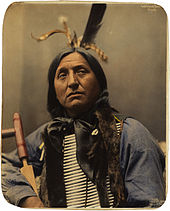Breastplate

A breastplate is a device worn over the torso to protect it from injury, as an item of religious significance, or as an item of status. A breastplate is sometimes worn by mythological beings as a distinctive item of clothing.
Armour
In medieval weaponry, the breastplate is the front portion of plate armour covering the torso. It has been a military mainstay since ancient times and was usually made of leather, bronze or iron in antiquity. By around 1000 AD, solid plates had fallen out of use in Europe and knights of the period were wearing mail in the form of a hauberk over a padded tunic.[1] Plates protecting the torso reappeared during the 13th century in the form of the cuirass or alternatively as plates directly attached to a knightly garment known as the surcoat.[1] Around 1300 this developed into the coat of plates which continued to be in use for about a century.[1] True breastplates reappear in Europe in 1340 first composed of wrought iron and later of steel.[2] They were between 1 mm and 2.5 mm thick.[2] In order to prevent the wearer from being cut by their own armour, the design featured outward turned edges that also increased stiffness.[2] In some cases, further strength was added by a ridge running down through the centre of the plate.[2] These early breastplates only covered the upper torso with the lower torso not being protected by plate until the development of the fauld around 1400.[2] Around 1450, the breastplate had expanded to cover the entire torso and could consist of one or two plates.[3] The French term pancier, which became English pauncher and German panzer, was also used.
Bullet-proof vests are the modern descendant of the breastplate.
Biblical
A "breastplate" or "breastpiece" was among the clothes of the Jewish High Priest. In the Bible, the word 'breastplate' is used figuratively to describe protecting oneself from unrighteousness (cf. Isaiah 59:17, Ephesians 6:14, etc.).
Classical mythology
Both Zeus and Athena are sometimes depicted as wearing a goatskin shield or breastplate called an Aegis. At the center of Athena’s shield was the head of Medusa.
Native American use


The hair-pipe breastplates of 19th-century Plains Indians were made from the West Indian conch, brought to New York docks as ballast and then traded to native Americans of the upper Missouri River. Their popularity spread rapidly after their invention by the Comanche in 1854. They were too fragile and expensive to be considered armour, and were instead a symbol of wealth during the economic depression among Plains Indians after the buffalo were almost exterminated.[4]
See also
References
- ^ a b c Walker, Paul F (2013). The history of armour 1100–1700. Crowood press. pp. 36–38. ISBN 9781847974525.
- ^ a b c d e Walker, Paul F (2013). The history of armour 1100–1700. Crowood press. pp. 39–41. ISBN 9781847974525.
- ^ Walker, Paul F (2013). The history of armour 1100–1700. Crowood press. p. 43. ISBN 9781847974525.
- ^ David E. Jones (2004). Native North American Armor, Shields, and Fortifications. Austin, TX: University of Texas. pp. 42–44. ISBN 0-292-70170-5.
External links
![]() Media related to Breastplates at Wikimedia Commons
Media related to Breastplates at Wikimedia Commons



